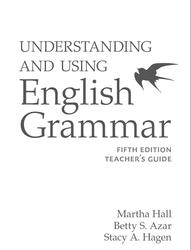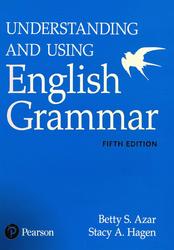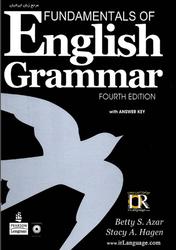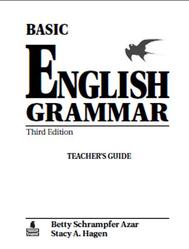Basic english grammar, Azar B.S., Hagen S.A., 2014.
Basic English Grammar is a developmental skills text for beginning English language learners.
It uses a grammar-based approach integrated with communicative methodologies to promote the development of all language skills in a variety of ways. Starting from a foundation of understanding form and meaning, students engage in meaningful communication about real actions, real things, and their own lives in the classroom context. Grammar tasks are designed to encourage both fluency and accuracy.
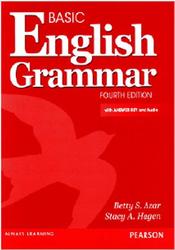
Примеры.
Looking at grammar.
Макс complete sentences.
1. He \ here He is here.
2. They \ absent
3. She \ sick
4. I \ homesick
5. You and I \ homesick
6. We Mate
7. Jack \ hungry
8. You (one person) \ early
9. You (two persons) \ early
10. Mr. and Mrs. Nelson \ late
11. Amy and I \ late.
Let's talk: game.
Part II. Sit in a circle. Student A makes a sentence using “I” and the first word.
Student В repeats the information about Student A and makes a new sentence using die second word. Continue around the circle until everyone in class has spoken. The teacher is the last person to speak and must repeat the information about everyone in the class.
Example:
Student A: I’m not hungry.
Student B: He’s not hungry. I’m thirsty.
Student C: He’s not hungry. She’s thirsty. I’m sleepy.
Contents.
Preface to the Fourth Edition.
Acknowledgments.
Chapter 1 USING BE.
1-1 Singular pronouns + be.
1-2 Plural pronouns + be.
1-3 Singular nouns + be.
1-4 Plural nouns + be.
1-5 Contractions with be.
1-6 Negative with be.
1-7 Be + adjective.
1-8 Be + a place.
1-9 Summary: basic sentence patterns with be.
Chapter 2 USING BE AND HAVE.
2-1 Yes/no questions with be.
2-2 Short answers to yes/no questions.
2-3 Questions with be: using where.
2-4 Using have and has.
2-5 Using my, your, her, his, our, their.
2-6 Using this and that.
2-7 Using these and those.
2-8 Asking questions with what and who + be.
Chapter 3 USING THE SIMPLE PRESENT.
3-1 Form and basic meaning of the simple present tense.
3-2 Frequency adverbs.
3-3 Position of frequency adverbs.
3-4 Spelling and pronunciation of final -es.
3-5 Adding final - s l-es to words that end in -y.
3-6 Irregular singular verbs: has, does, goes.
3-7 Like to, want to, need to.
3-8 Simple present tense: negative.
3-9 Simple present tense: yes/no questions.
3-10 Simple present tense: asking information questions with where.
3-11 Simple present tense: asking information questions with when and what tim e.
Chapter 4 USING THE PRESENT PROGRESSIVE.
4-1 Be + -ing: the present progressive.
4-2 Spelling of -ing.
4-3 Present progressive: negatives.
4-4 Present progressive: questions.
4-5 Simple present tense vs. the present progressive.
4-6 Non-action verbs not used in the present progressive.
4-7 See, look at, watch, hear, and listen to.
4-8 Think about and think that.
Chapter 5 TALKING ABOUT THE PRESENT.
5-1 Using it to talk about time.
5-2 Prepositions of time.
5-3 Using it and what to talk about the weather.
5-4 There + be.
5-5 There + be: yes/no,questions.
5-6 There + be: asking questions with how many.
5-7 Prepositions of place.
5-8 More prepositions of place: a list.
5-9 Would like.
5-10 Would like vs. like.
Chapter 6 NOUNS AND PRONOUNS.
6-1 Nouns: subjects and objects.
6-2 Nouns as objects of prepositions.
6-3 Adjectives with nouns.
6-4 Subject pronouns and object pronouns.
6-5 Nouns: singular and plural forms.
6-6 Nouns: irregular plural forms.
6-7 Possessive pronouns: mine, yours, his, hers, ours, theirs.
6-8 Possessive nouns.
6-9 Questions with whose.
6-10 Possessive: irregular plural nouns.
Chapter 7 COUNT AND NONCOUNT NOUNS.
7-1 Nouns: count and noncount.
7-2 Using a vs. an.
7-3 Using a/an vs. some.
7-4 Measurements with noncount nouns.
7-5 Using many, much, a few, a little.
7-6 Using the.
7-7 Using 0 (no article) to make generalizations.
7-8 Using some and any.
Chapter 8 EXPRESSING PAST TIME, PART 1.
8-1 Using be: past time.
8-2 Simple past tense of be: negative.
8-3 Past of be: questions.
8-4 Simple past tense: using -ed.
8-5 Past time words: yesterday, last, and ago.
8-6 Simple past tense: irregular verbs (Group 1).
8-7 Simple past tense: negative.
8-8 Simple past tense: yes/no questions.
8-9 Simple past tense: irregular verbs (Group 2).
8-10 Simple past tense: irregular verbs (Group 3).
8-11 Simple past tense: irregular verbs (Group 4).
Chapter 9 EXPRESSING PAST TIME, PART 2.
9-1 Simple past tense: using where, why, when, and what time.
9-2 Questions with what.
9-3 Questions with who and whom.
9-4 Simple past tense: irregular verbs (Group 5).
9-5 Simple past tense: irregular verbs (Group 6).
9-6 Simple past tense: irregular verbs (Group 7).
9-7 Before and after in time clauses.
9-8 When in time clauses.
9-9 Present progressive and past progressive.
9-10 Using while with past progressive.
9-11 Simple past tense vs. past progressive.
Chapter 1 0 EXPRESSING FUTURE TIME, PART 1.
10-1 Future time: using be going to.
10-2 Using present progressive to express future time.
10-3 Words used for past time and future time.
10-4 Using a couple of or afew with ago (past) and in (future).
10-5 Using today, tonight, and this + morning, afternoon, evening, week, month, year.
1 0-6 Future time: using will.
10-7 Asking questions with will.
10-8 Verb summary: present, past, and future.
10-9 Verb summary: forms of be.
Chapter 11 EXPRESSING FUTURE TIME, PART 2.
11 -1 May/might vs. will.
11-2 Maybe (one word) vs. may be (two words).
11-3 Future time clauses with before, after, and when.
11-4 Clauses with if.
11-5 Expressing future and habitual present with time clauses and if-clauses.
11-6 Using what + a form of do.
Chapter 12 MODALS, PART 1: EXPRESSING ABILITY.
12-1 Using can.
12-2 Pronunciation of can and can't.
12-3 Using can: questions.
12-4 Using know how to.
12-5 Using could: past of can.
12-6 Using be able to.
12-7 Using very and too + adjective.
Chapter 13 MODALS, PART 2: ADVICE, NECESSITY, REQUESTS, SUGGESTIONS.
13-1 Using should.
13-2 Using have + infinitive (have to/has to/had to).
13-3 Using must~ have to/has to~ and should.
13-4 Polite questions: may I, could I, and can I.
13-5 Polite questions: could you and would you.
13-6 Imperative sentences.
13-7 Modal auxiliaries.
13-8 Summary chart: modal auxiliaries and similar expressions.
13-9 Using let's.
Chapter 14 NOUNS AND MODIFIERS.
14-1 Modifying nouns with adjectives and nouns.
14-2 Word order of adjectives.
14-3 Linking verbs + adjectives.
14-4 Adjectives and adverbs.
14-5 Expressions of quantity: all o,h most o,h some o,h almost all of.
14-6 Expressions of quantity: subject-verb agreement.
14-7 Using every, everyone, everybody, everything.
14-8 Indefinite pronouns: something~ someone, somebody, anything, anyone, anybody.
Chapter 15 MAKING COMPARISONS.
15-1 The comparative: using -er and more.
15-2 The superlative: using -est and most.
15-3 Using one of+ superlative + plural noun.
15-4 Making comparisons with adverbs.
15-5 Comparisons: using the same (as), similar (to), and different (from).
15-6 Comparisons: using like and alike.
15-7 Using but.
15-8 Using verbs after but.
Appendix 1 English Handwriting.
Appendix 2 Numbers.
Appendix 3 Ways of Saying Time.
Appendix 4 Days/Months/Seasons.
Appendix 5 Supplementary Charts.
AS-I Basic capitalization rules.
AS-2 Voiceless and voiced sounds for-s endings on verbs.
AS-3 Final -ed pronunciation for simple past verbs.
Listening Script.
Let's Talk: Answers.
Answer Key.
Index.
Audio CD Tracking List.
Бесплатно скачать электронную книгу в удобном формате, смотреть и читать:
Скачать книгу Basic english grammar, Azar B.S., Hagen S.A., 2014 - fileskachat.com, быстрое и бесплатное скачивание.
Скачать pdf
Ниже можно купить эту книгу, если она есть в продаже, и похожие книги по лучшей цене со скидкой с доставкой по всей России.Купить книги
Скачать - pdf - Яндекс.Диск.
Дата публикации:
Теги: учебник по английскому языку :: английский язык :: Azar :: Hagen
Смотрите также учебники, книги и учебные материалы:
Следующие учебники и книги:
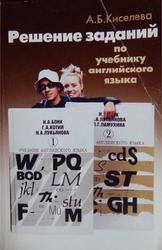 Решение заданий по учебнику английского языка, Киселева А.Б., 2007 — Данное дополнительное пособие к двухтомному Учебнику английского языка (том I Н. А. Бонк, Г. А. Котий, Н. А. Лукьянова; том … Книги по английскому языку
Решение заданий по учебнику английского языка, Киселева А.Б., 2007 — Данное дополнительное пособие к двухтомному Учебнику английского языка (том I Н. А. Бонк, Г. А. Котий, Н. А. Лукьянова; том … Книги по английскому языку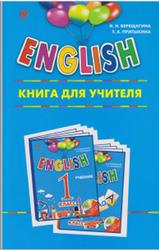 English, 1 класс, книга для учителя, Верещагина И.Н., Притыкина Т.А., 2017 — Данная книга входит в состав учебно-методического комплекта по английскому языку для учащихся 1-го класса школ и старших групп детских садов. … Книги по английскому языку
English, 1 класс, книга для учителя, Верещагина И.Н., Притыкина Т.А., 2017 — Данная книга входит в состав учебно-методического комплекта по английскому языку для учащихся 1-го класса школ и старших групп детских садов. … Книги по английскому языку English, 1 класс, Верещагина И.Н., Притыкина Т.А., 2017 — Учебник представляет собой начальный устный курс английского языка для учащихся 1-го класса школ. Он поможет детям 6 7 лет освоить … Книги по английскому языку
English, 1 класс, Верещагина И.Н., Притыкина Т.А., 2017 — Учебник представляет собой начальный устный курс английского языка для учащихся 1-го класса школ. Он поможет детям 6 7 лет освоить … Книги по английскому языку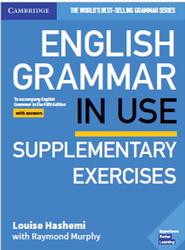 English Grammar in Use, Supplementary Exercises, Hashemi L., Murphy R., 2019 — English Grammar in Use Supplementary Exercises is for intermediate and advanced students who want extra practice in grammar, without help … Книги по английскому языку
English Grammar in Use, Supplementary Exercises, Hashemi L., Murphy R., 2019 — English Grammar in Use Supplementary Exercises is for intermediate and advanced students who want extra practice in grammar, without help … Книги по английскому языку
Предыдущие статьи:
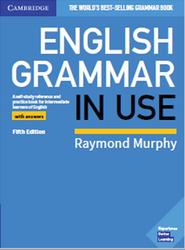 English Grammar in Use, Murphy R., 2019 — English Grammar in Use was written as a self-study grammar book, but teachers may also find it useful as additional … Книги по английскому языку
English Grammar in Use, Murphy R., 2019 — English Grammar in Use was written as a self-study grammar book, but teachers may also find it useful as additional … Книги по английскому языку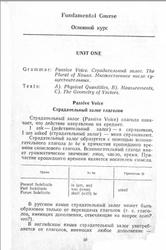 Учебник английского языка для физиков, основной курс, Поталуева А.А., Хомутова Е.В., 1989 — Фрагмент из текста: Страдательный залог (Passive Voice) глагола означает, что действие направлено на предмет. I ask (действительный залог) я спрашиваю, … Книги по английскому языку
Учебник английского языка для физиков, основной курс, Поталуева А.А., Хомутова Е.В., 1989 — Фрагмент из текста: Страдательный залог (Passive Voice) глагола означает, что действие направлено на предмет. I ask (действительный залог) я спрашиваю, … Книги по английскому языку Учебник английского языка для физиков, вводный курс, Поталуева А.А., Хомутова Е.В., 1989 — Фрагмент из текста: Глагол в настоящем времени неопределенной формы обозначает действие, свойственное подлежащему, происходящее обычно, регулярно. Bob speaks French very … Книги по английскому языку
Учебник английского языка для физиков, вводный курс, Поталуева А.А., Хомутова Е.В., 1989 — Фрагмент из текста: Глагол в настоящем времени неопределенной формы обозначает действие, свойственное подлежащему, происходящее обычно, регулярно. Bob speaks French very … Книги по английскому языку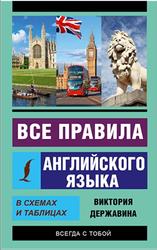 Все правила английского языка в схемах и таблицах, Державина В.А., 2018 — Данный справочник содержит базовый курс английской грамматики. Все правила проиллюстрированы примерами с переводом на русский язык. Простые таблицы и схемы … Книги по английскому языку
Все правила английского языка в схемах и таблицах, Державина В.А., 2018 — Данный справочник содержит базовый курс английской грамматики. Все правила проиллюстрированы примерами с переводом на русский язык. Простые таблицы и схемы … Книги по английскому языку

